To disassemble and repair a car engine, you will need: keys «for 8», «on 10», «at 13», «at 17», «at 19», interchangeable heads «on 10», «at 13», «at 17», «at 19», hex socket wrenches «by 5» And «on 10», knob, pliers, screwdriver, a set of flat probes, micrometers (with measurement limits 0-25, 25-50 and 75-100 mm), caliper, dial gauge with indicator stand, torque wrench, oil filter puller.
1. Remove the engine from the car (see «Removal and installation of the engine»).
2. Place the engine on firm stands.
3. Disconnect the gearbox from the engine (see «Removal and installation of a transmission»).
4. Remove the clutch from the engine (see «Removal and installation of clutch»).
5. Remove the timing belt (camshaft drive), tension roller and spacer installed under it (see «Timing belt replacement (camshaft drive) and tension roller»).
6. Remove the camshaft sprocket (see «Replacing the cylinder head gasket»).

7. Turn out four bolts (three of them also mount the water pump) and the timing belt rear cover fastening nut, remove the rear cover.

8. Insert a screwdriver between the flange of the water pump housing and the block, slide the pump out of its seat. Remove the water pump.
9. Remove the head from the cylinder block (see «Replacing the cylinder head gasket»).
10. Turn out sixteen bolts of fastening of an oil case and remove it together with a lining.

11. Turn out three bolts of fastening of an oil receiver (spring washers are installed under the bolt heads) and take it off.

12. Turn the crankshaft so that the piston to be removed is at BDC (bottom dead center). Loosen the two connecting rod cap nuts.

13. Remove the connecting rod cover. If it is difficult to remove the connecting rod cap, first remove it with light blows from a hammer. The cylinder number on the connecting rod cap may not be visible, in which case mark the connecting rod cap with the cylinder number.

14. Push the connecting rod with a hammer handle into the cylinder and carefully remove the piston with the connecting rod from the cylinder. At the same time, make sure that the lower head of the connecting rod does not touch the cylinder mirror, otherwise the mirror may be damaged. Remove the rest of the pistons in the same way.
15. Remove the flywheel (see «Removal, troubleshooting and installation of the flywheel»).

16. Turn out six bolts (spring washers are installed under their heads), remove the crankshaft rear oil seal retainer and gasket.

17. Remove the toothed pulley from the crankshaft. If the key in the groove of the crankshaft is loose, remove it so as not to lose it.
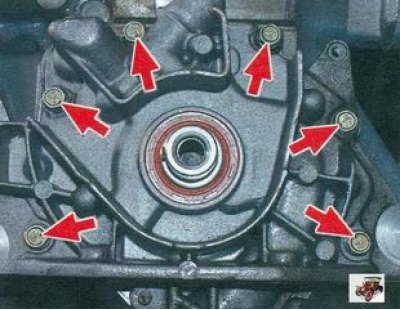
18. Turn out six bolts (spring washers are installed under their heads), remove the oil pump and gasket.

19. Turn out on two bolts of fastening of five covers of radical bearings.
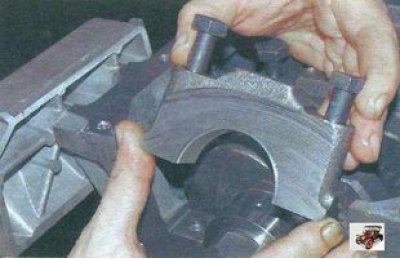
20. Remove the main bearing caps. The main bearing caps are marked with notches according to the cylinder numbers. If these marks are not clearly visible, be sure to additionally mark the main bearing caps to reinstall them in their original places: main bearing caps are not interchangeable (cylinder block machined together with main bearing caps).
21. Remove the crankshaft.
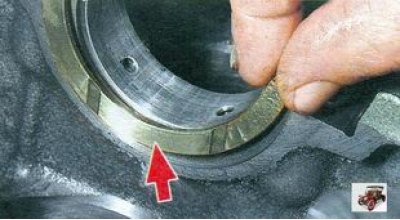
22. Remove the crankshaft thrust washers on the middle support.

23. Take out loose leaves from covers of radical bearings and beds of the block.
24. If it is not intended to replace the main bearing shells, when removing, mark the shells on the non-working side with respect to covers and beds.
25. If it is necessary to remove the brackets of the generator and the right engine mount, unscrew the three bolts of their fastening.
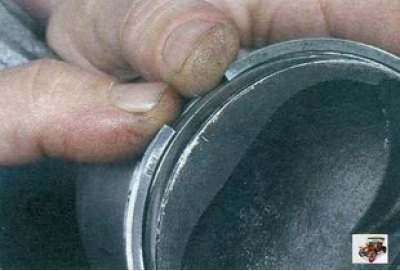
26. Remove the piston rings with a special puller. If it is not there, remove the rings from the piston by carefully spreading the locks of the rings.
27. Remove the oil scraper ring expander from the piston.

28. Remove the circlips holding the piston pin on both sides of the piston. For the convenience of removing the piston rings, recesses are made in the piston bosses.
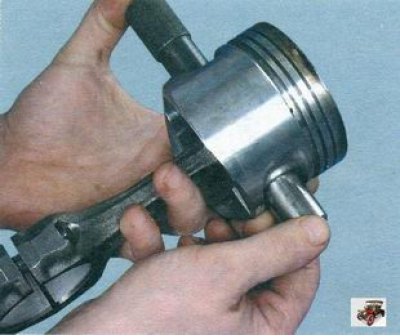
29. Using a suitable mandrel, push the piston pin out of the piston and remove the piston from the connecting rod.
30. Take out loose leaves from a rod and its cover. If the liners remain on the crankshaft, remove them from the shaft. If the bushings are not to be replaced, mark them on the non-working surface with respect to the connecting rods and caps when removing them.
